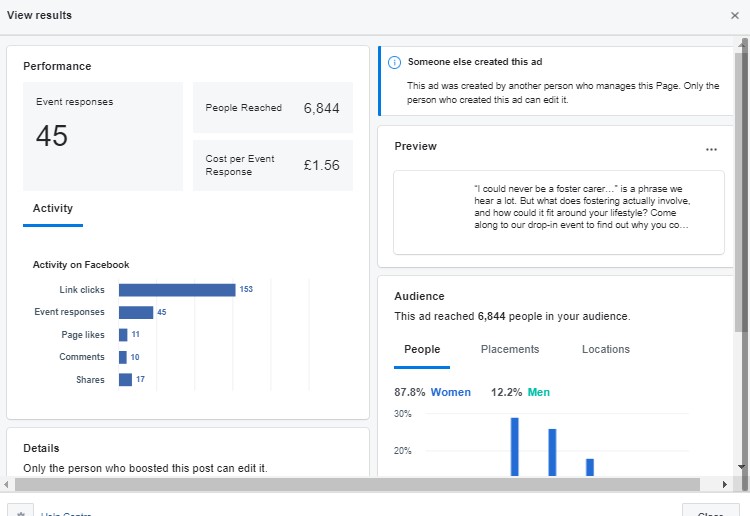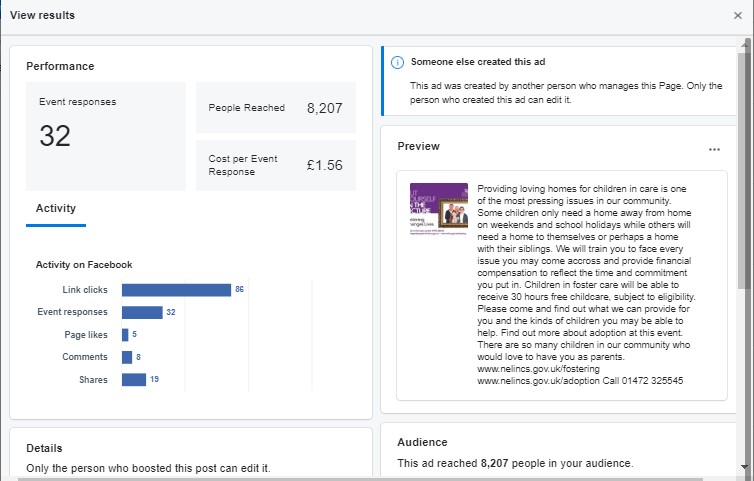In the 2017/18 financial year, North East Lincolnshire Council followed the national trend of low fostering recruitment.
In this year, our council approved just four foster carers. Using insights gathered with the public we were able to identify barriers and misconceptions that may be stopping individuals from pursuing fostering as a career and then tailor our messages around these findings.
As a result we have more than doubled the number of carers in 2018/19 and started to see more individuals engage in a dialogue about fostering.
The challenge
Fostering is a key priority in our council’s ‘Outcomes framework’ ensuring the members of its community enjoy good health and wellbeing, feel safe and are safe, live in strong, sustainable communities and fulfil their potential through skills and learning.
Low interest in fostering meant paying more for private agencies to house our children. As well as causing a big strain on budgets this caused the added disruption of moving our children away from the area during an already difficult time. This also places further strain on social workers who need to travel greater distances to conduct visits.
Fostering is broadly accepted as a challenging role and most people come to the conclusion about whether they can or cannot foster in a matter of seconds. Fostering was a closed door. The challenge was to open it and start to breakdown some of the barriers people had built up about fostering.
The solution
We spoke to individuals in the public using a short survey as our basis to gather qualitative information.
The majority of these individuals had no experience of fostering either through their own experience or through friends or family.
Our insights showed us that a lot of guesswork was going on around fostering and most people had hard and fast conclusions about the role that were based on a very limited understanding without much room to be challenged. There was not much thought to the varied types of people who foster, the impact they have on children and the community, the enriching experience of a foster carer, the community you become a part of or even the kind of issues you would face.
Nearly everyone we spoke to said fostering would be “challenging but rewarding”. However, when pressed further their knowledge or opinions of fostering, or lack thereof, indicated that they had not really considered it at any length.
It seemed the enormity of the challenges they imagined came first and foremost meaning they would not really consider if it was for them now or at some point in the future or even that they had a part to play by being an advocate. Fostering was painted as an all-consuming, inflexible role which they had no business entertaining.
The uninformed, sweeping generalisation of the role of a foster carer was soon replaced with a vague, imagined ‘worst-case scenario’ in which one could not cope; this determined if the conversation went any further.
Another finding was the broad misconception that there was an upper-age bracket. Everyone we surveyed aged over 50 indicated, ‘I must be out of the age range to foster now so no use speaking to me’.
When they were told that there was no upper age bracket and that we had older foster carers who were perfect candidates because of their life experience and having spare rooms, many did not shut down the idea so it was clear that some work could be done here with this demographic.
Another key finding was the number of people who said they could only be persuaded to foster if they knew we were ‘really desperate’. Lacking loving homes for the children in our community who need love the most could be described as a ‘desperate’ situation.
The impact
As well as seeing foster care applications and approvals increase to ten by the end of the year compared to four from the previous year, we have seen more dialogue from people who say they cannot foster but wish the best for the kids and have shared our events.
This can go a long way to uplifting the tone of a difficult subject and is an indication that our messages are reaching a wider audience, perhaps planting the seeds for future foster carers who may not have otherwise considered it.
On average, the growth in fostering approvals has saved the Council over £250,000 compared to if our children had been in private foster care, and of course this contributes to the socio-economic costs of improved outcomes for the youngsters who are fostered closer to home.
How is the new approach being sustained?
The insight led approach has been accepted by the fostering service.
So far we have used our insights across all our communications including paid-for print, social media, and radio. However, we have found that the best value for money comes through our boosted Facebook advertisements.
(This event was boosted for £50 over one week and reached over 6,000 people leading to 153 link clicks.)
The message opens with a quote addressing many people’s first comment when we surveyed them. “I could never be a foster carer…” In a conversational style I went on to address this misconception and try to cast doubt on people’s belief that they couldn’t foster. The text challenges the idea that fostering will disrupt their ‘normal’ by detailing that there are many different types of fostering that could suit their lifestyle.
(This event was boosted for £50 over one week and reached over 8,000 people leading to 86 link clicks.)
Another common finding from the survey was that people did not realise the high and growing demand for foster carers or the implications of not having enough local foster carers. Many people said “I would only foster if I knew you really needed them.”
This boosted event description opens with the urgency of finding foster carers. Followed by a breakdown of the types of fostering available and some of the support available.
This text focusses on the practical side of fostering ‘providing homes’- it led to less engagement.
It may have been more successful to state our urgent need in a re-post of the event and using some quotes from a foster carer in the event description followed by the practical ‘training, support, financial compensation’ etc.
The potential foster carer wants to know that they are in safe hands so it is important to distinguish when to ask what the foster carer can do for a child and what our service can provide to the foster carer. So the re-post may have said: “Children in our area urgently need people like you. Please speak to our friendly team to find out what we can do for you.”
Comparable events that were not boosted led to significantly less event engagement and less reach.
Our messages also include myth busting and highlight the various ways in which foster carers are equipped to handle difficult issues that may put them off.
Further to this we would like to trial and test messages co-produced with kids in care, adults who have come through care, and the birth children of foster parents.
When asked about the impact individuals could have on fostering by involving others in their network the common sentiment was ‘well I don’t have an interest in fostering so I hadn’t thought about sharing it with my family or friends’.
This insight made it clear that a lot of progress could be made by pulling fostering out of the minds of the small pocket of society who were so kind and moral that they would be willing to disrupt their ‘nice lifestyle’ and into the minds of the wider community. To make inroads I simply state “If you cannot foster, this message is still for you, please share this with your family and friends. Helping children is a community effort.’ Further to this there is a lot of work to be done to bring to light the vast common ground shared between people who do and do not foster.
While the increase in foster carers in 2018/2019 is a success the following years will be the time to prove that these messages are working and it is our insights that are engaging the public. Also, the increase in recruitment must be considered against retainment because every year we have foster carers retire and leave the service. Some of whom do so because demands on them are increasing. Coupling this with the rising number of looked after children means it will become imperative to explore new ways to use insights to increase the number of foster carers recruited each year.
Lessons learned
One of the key insights learned was the amount of guess work regarding life as a foster carer and how quickly people’s assumptions and fears lead them to a firm ‘no’ with no room to reconsider.
Although we use our insights across all platforms we have found the best value for money comes from social media where we can not only target an audience and measure engagement, but follow up the dialogue by replying to queries, putting facts straight from naysayers and thanking people for their interest.
While we have broken the back of the misconceptions held around fostering we can still see from some of the engagement with the public that more work can be done to discredit some of the horror stories that take over people’s perception of fostering.
We also identified the large number of older people who wrongly assumed they could not foster. This is a potential market to target, however, after trying a few inroads and finding this smaller market more difficult to engage with it was determined that we should make best use of the broader market before drilling into this demographic.
Additionally, we are reflecting on what we have learned from this work to develop a new local insight led recruitment campaign for children’s social workers.
This year has been a chance to gather and test insights we have gained laying the foundation for our future efforts. There is a lot more work that can be done to de-mystify fostering as a career and a ‘lifestyle’ and bring it into the realm of everyday life for a wide audience who previously sat in the dark of this pressing issue.
Contact
[email protected]
01472 323337
Relevant documents
Fostering messages examples


